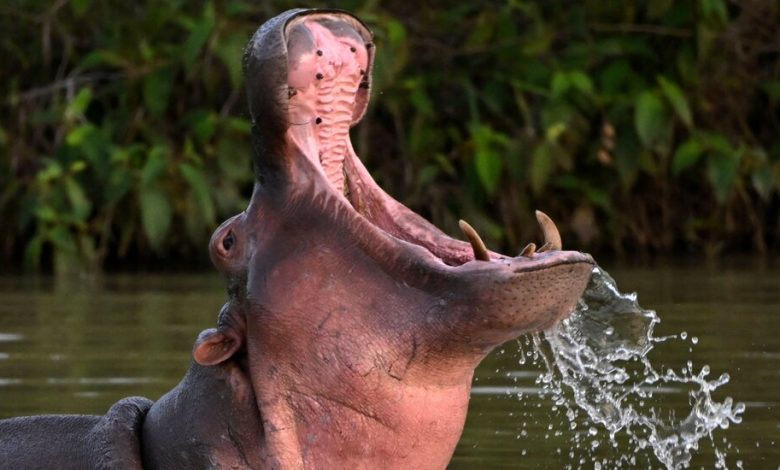Colombia to Sterilize Pablo Escobar’s ‘Cocaine Hippos’

When the Colombian drug lord Pablo Escobar was killed in 1993, most of the animals he had imported as pets — zebras, giraffes, kangaroos and rhinoceroses — died or were transferred to zoos.
But not his four hippopotamuses. They thrived. Perhaps a little too well.
Officials estimate that about 170 hippos, descended from Mr. Escobar’s original herd, now roam Colombia, and the population could grow to 1,000 by 2035, posing a serious threat to the country’s ecosystem.
This month, after years of debate about what to do with the voracious herbivores, Colombian officials announced a plan to sterilize some, possibly euthanize others and relocate some to sanctuaries in other countries. On Friday, one official said that four hippos — two adult females and two juvenile males — had already been surgically sterilized.
“We are in a race against time in terms of permanent environmental and ecosystem impacts,” Susana Muhamad, Colombia’s environmental minister, said in a statement.
Colombian officials describe the hippos as an aggressive and invasive species with no natural predators.
Mr. Escobar brought the first four to his lavish estate, Hacienda Nápoles, in the 1980s as part of a wild animal menagerie he used to entertain guests.
Mr. Escobar’s son, Juan Pablo Escobar, wrote in a book, “Pablo Escobar: My Father,” that his father traveled in the early 1980s to a wildlife breeding center in Dallas, where he negotiated a deal to have the animals brought to his estate. Hacienda Nápoles also had an airstrip, swimming pools and a 1,000-seat bull ring.
After Mr. Escobar was killed in a rooftop shootout with security forces in Medellín in 1993, his hippos fended for themselves. They waddled into an artificial pond and reproduced, drawing affection and ire as their numbers multiplied.
The animals, for better or worse, became recognizable mascots in Colombia, memorialized in sculptures, including one of a giant pink hippo named Vanesa that greets visitors to Mr. Escobar’s former estate, which has been turned into a theme park.
In the United States, the news media has less nobly referred to them as “cocaine hippos.”
A hunting party that included Colombian soldiers, hoping to stop the hippos from spreading beyond Mr. Escobar’s estate, shot and killed one named Pepe in 2009. The hunt prompted a public outcry, fueled by the publication of a photo of the soldiers posing with the dead hippo. A judge in Medellín later suspended the hunt for Pepe’s mate and their offspring.
Ms. Muhamad blamed 30 years of government inaction for allowing the hippos to multiply far from their native habitat in sub-Saharan Africa. She said that 130 to 150 live in the Magdalena River, Colombia’s principal river.
The government’s goal is to sterilize 40 hippos a year.
But sterilizing a hippo is not like spaying or neutering a cat.
Hippos can weigh more than three tons and spend most of their days wallowing in the water, so they’re easiest to capture at night. Experts said they are generally tranquilized with a dart and undergo surgery wherever they land. If they run into the water after being hit with a dart, they could drown, experts said.
“This procedure is very dangerous since the veterinarian must be very skilled to sterilize it in the shortest time possible, before it wakes up,” said Germán Jiménez, a biologist at the Pontifical Javeriana University in Colombia.
The hippos could also be lured into a paddock baited with vegetables, where it might be easier to operate on them, said Jonathan Shurin, an ecologist at the University of California, San Diego, who has researched the effects of the hippos on water quality in Colombia.
“Getting them sedated in a position where you can work on them is the hardest part,” Dr. Shurin said, adding that the undertaking is “not for amateurs.”
Colombian officials say each sterilization will cost about 40 million pesos, or roughly $10,000, and will require a team of eight people, including veterinarians, technicians and support staff.
Ms. Muhamad said the government was also developing an “ethical euthanasia protocol,” but did not say how many hippos might be targeted or by what method.
Andrea Padilla, a Colombian senator and animal rights activist, said she supported the plan, as long as it did not call for killing healthy hippos. Euthanasia should be a last resort, she said, “mainly in cases of sick animals whose suffering warrants it.”
“The important thing is to act quickly and effectively” in sterilizing as many hippos as possible, she said, transferring others to sanctuaries and confining the population.
Dr. Shurin said that it would be “much more effective and humane” to control the population when it’s small than when it’s large and might require extensive hunting.
“It’s led to a lot of strong emotions and tempers on both sides,” he said. “I think the plan they’ve come out with is very reasonable and sensible, and you’ll be able to see if it works if you don’t see baby hippos around.”
Researchers have warned that the hippos, if left unchecked, could displace other mammals, such as manatees and capybaras, and that the large amount of waste they produce could alter aquatic ecosystems, leading to harmful algal blooms. As the hippos spread, they could also come into more frequent contact with people.
In April, Aníbal Gaviria Correa, the governor of the Colombian region of Antioquia, posted a photo on social media of a dead hippo in a road after it was hit by a car. He implored Ms. Muhamad and Colombia’s president, Gustavo Petro, to expedite the relocation of what he called “these majestic animals.”
Ms. Muhamad said the government was in talks to have some of the hippos relocated to sanctuaries in Mexico, India and the Philippines.
Dr. Jiménez expressed concerns about the plans outlined so far, saying they “aren’t enough to control” the exploding hippo population. If the hippos aren’t eliminated entirely, he said, Colombia must consider “living with this species permanently.”
